Study of the Jet Output Characteristics under Multi−Source Coupling
Abstract
:1. Introduction
2. Tool Structure and Principle
3. Establishment of the Structural Model and Flow Field
3.1. Establishment of the Physical Model and Parameter Design
3.2. Establishment of the Mathematical Model
3.3. Setting the Boundary Conditions
4. Analysis of the Numerical Simulation Results
5. Test Verification
5.1. Ground Test of the Multi−Source Pulsed Jet Generator Output Characteristic
5.2. Prototype Test of the Multi−Source Impact Oscillation Speed−Increasing Tool
6. Conclusions
Author Contributions
Funding
Conflicts of Interest
References
- Su, Y. Introduction to the theory and technology on downhole control engineering and its research progress. Pet. Explor. Dev. 2018, 45, 754–763. [Google Scholar] [CrossRef]
- Gao, D. A high−efficiency development mode of shale gas reservoirs in mountainous areas based on large cluster horizontal well engineering. Nat. Gas Ind. B 2019, 6, 122–128. [Google Scholar] [CrossRef]
- Wang, H.; Liao, H.; Wei, J.; Liu, Y.; Niu, W.; Latham, J.-P.; Xiang, J.; Liu, J.; Chen, J. Pressure Drop Model and Jet Features of Ultra High Pressure Water Jet for Downhole Intensifier. J. Energy Resour. Technol. 2022, 144, 123005. [Google Scholar] [CrossRef]
- Kuanliang, Z.; Jinghai, F.; Fei, H.; Nan, L. Pilot test of horizontal drilling and completion techniques in Nanpu Oilfield. Pet. Explor. Dev. 2009, 36, 658–663. [Google Scholar] [CrossRef]
- Guo, B.; Li, J.; Feng, Y. How Much Can You Extend the Reach of Coiled Tubing in Horizontal Wells Using Pressure−Hammer/Pulsing Tools. In Proceedings of the Society of Petroleum Engineers—SPE USA Unconventional Resources Conference, The Woodlands, TX, USA, 10–12 April 2013. [Google Scholar]
- Wang, H.-J.; Liao, H.-L.; Wei, J.; Liu, J.-S.; Niu, W.-L.; Liu, Y.-W.; Guan, Z.-C.; Sellami, H.; Latham, J.-P. Stress release mechanism of deep bottom hole rock by ultra−high−pressure water jet slotting. Pet. Sci. 2023, 1995–8226. [Google Scholar] [CrossRef]
- Sauki, A.; Khamaruddin, P.N.F.M.; Irawan, S.; Kinif, I.; Ridha, S.; Ali, S.A.; Ali, M.A. Development of a modified Bourgoyne and Young model for predicting drilling rate. J. Pet. Sci. Eng. 2021, 205, 108994. [Google Scholar] [CrossRef]
- Schunnesson, H. Rock characterisation using percussive drilling. Int. J. Rock Mech. Min. Sci. 1998, 35, 711–725. [Google Scholar] [CrossRef]
- Ghasemloonia, A.; Rideout, D.G.; Butt, S.D. A review of drillstring vib Fluid hammer analysis with unsteady flow friction model in coiled tubing drilling ration modeling and suppression methods. J. Pet. Sci. Eng. 2015, 131, 150–164. [Google Scholar] [CrossRef]
- Sarker, M.; Rideout, D.G.; Butt, S.D. Dynamic model for longitudinal and torsional motions of a horizontal oilwell drillstring with wellbore stick−slip friction. J. Pet. Sci. Eng. 2016, 150, 272–287. [Google Scholar] [CrossRef]
- Sarker, M.; Rideout, D.G.; Butt, S.D. Dynamic model for 3D motions of a horizontal oilwell BHA with wellbore stick−slip whirl interaction. J. Pet. Sci. Eng. 2017, 157, 482–506. [Google Scholar] [CrossRef]
- Li, S.; Vaziri, V.; Kapitaniak, M.; Millett, J.M.; Wiercigroch, M. Application of Resonance Enhanced Drilling to coring. J. Pet. Sci. Eng. 2020, 188, 106866. [Google Scholar] [CrossRef]
- Zhang, W.; Shi, H.; Li, G.; Song, X.; Zhao, H. Mechanism analysis of friction reduction in coiled tubing drilling with axial vibratory tool. J. Pet. Sci. Eng. 2019, 175, 324–337. [Google Scholar] [CrossRef]
- Li, Z.; Zhang, C.; Song, G. Research advances and debates on tubular mechanics in oil and gas wells. J. Pet. Sci. Eng. 2017, 151, 194–212. [Google Scholar] [CrossRef]
- Wang, P.; Ni, H.; Wang, R.; Li, Z. Modulating downhole cuttings via a pulsed jet for efficient drilling−tool development and field testing. J. Nat. Gas Sci. Eng. 2015, 27, 1287–1295. [Google Scholar] [CrossRef]
- Wang, P.; Ni, H.; Wang, R. A novel vibration drilling tool used for reducing friction and improve the penetration rate of petroleum drilling. J. Pet. Sci. Eng. 2018, 165, 436–443. [Google Scholar] [CrossRef]
- Peng, J.; Ge, D.; Zhang, X.; Wang, M.; Wu, D. Fluidic DTH hammer with backward−impact−damping design for hard rock drilling. J. Pet. Sci. Eng. 2018, 171, 1077–1083. [Google Scholar] [CrossRef]
- Shi, X.; Huang, W.; Gao, D.; Zhu, N. Optimal design of drag reduction oscillators by considering drillstring fatigue and hydraulic loss in sliding drilling. J. Pet. Sci. Eng. 2022, 208, 109572. [Google Scholar] [CrossRef]
- Mu, Z.; Li, G.; Sun, Z.; Huang, Z.; Song, H. Mechanism research and field test of a novel axial vibratory tool for friction reduction in long horizontal wells. J. Pet. Sci. Eng. 2022, 208, 109534. [Google Scholar] [CrossRef]
- Mu, Z.; Huang, Z.; Sun, Z.; Wu, X.; Li, G.; Song, X. Experimental study on dynamic characteristics of axial−torsional coupled percussive drilling. J. Pet. Sci. Eng. 2022, 219, 111094. [Google Scholar] [CrossRef]
- Říha, Z.; Zeleňák, M.; Kruml, T.; Poloprudský, J. Comparison of the disintegration abilities of modulated and continuous water jets. Wear 2021, 478–489, 203891. [Google Scholar] [CrossRef]
- Song, H.; Shi, H.; Li, G.; Chen, Z.; Li, X. Numerical simulation of the energy transfer efficiency and rock damage in axial−torsional coupled percussive drilling. J. Pet. Sci. Eng. 2021, 196, 107675. [Google Scholar] [CrossRef]
- Zhang, W.; Shi, H.; Li, G.; Song, X. Fluid hammer analysis with unsteady flow friction model in coiled tubing drilling. J. Pet. Sci. Eng. 2018, 167, 168–179. [Google Scholar] [CrossRef]
- Shi, X.-L.; Huang, W.-J.; Gao, D.-L. Mechanical behavior of drillstring with drag reduction oscillators and its effects on sliding drilling limits. Pet. Sci. 2021, 18, 1689–1697. [Google Scholar] [CrossRef]
- Shi, H.; Li, G.; Guo, B.; He, Z. Hydraulic pulse jet: Test of characteristics and field applications in ultra−deep wells. J. Nat. Gas Sci. Eng. 2015, 27, 200–206. [Google Scholar] [CrossRef]
- Li, H.; Liu, S.; Zhou, F.; Jiang, H.; Wang, F.; Guo, C. Experimental investigation on concrete rock breaking performance of self−excited oscillation pulsed waterjet. Eng. Fract. Mech. 2022, 268, 108502. [Google Scholar] [CrossRef]
- Zhang, S.; Fu, B.; Sun, L. Investigation of the Jet Characteristics and Pulse Mechanism of Self−Excited Oscillating Pulsed Jet Nozzle. Processes 2021, 9, 1423. [Google Scholar] [CrossRef]
- Geveci, M.; Oshkai, P.; Rockwell, D.; Lin, J.-C.; Pollack, M. Imaging of the self−excited oscillation of flow past a cavity during generation of a flow tone. J. Fluids Struct. 2003, 18, 665–694. [Google Scholar] [CrossRef] [Green Version]
- Shi, D.; Xing, Y.; Wang, L.; Chen, Z. Numerical Simulation and Experimental Research of Cavitation Jets in Dual−Chamber Self−Excited Oscillating Pulsed Nozzles. Shock. Vib. 2022, 2022, 1268288. [Google Scholar] [CrossRef]
- Guan, Z.; Zhang, H.; Zhang, W.; Liu, Y.; Liang, D. Equipment and technique for improving penetration rate by the transformation of drill string vibration to hydraulic pulsating jet. Pet. Explor. Dev. 2014, 41, 678–683. [Google Scholar] [CrossRef]
- Yang, Y.; Liao, H.; Xu, Y.; Niu, J.; Yang, L. Theoretical investigation of the energy transfer efficiency under percussive drilling loads. Arab. J. Geoences 2019, 12, 175. [Google Scholar] [CrossRef]
- Yang, Y.; Liao, H.; Niu, J.; Wang, Z.; Chen, J. Three−dimensional simulation of rock breaking efficiency under various impact drilling loads. Arab. J. Geosci. 2020, 13, 444. [Google Scholar] [CrossRef]
- Yang, Y.; Liao, H.; Xu, Y.; Yang, S.; Niu, J. Coupled fluid−structure simulation of a vibration−assisted rotary percussion drilling tool. Energy Sources 2019, 41, 1725–1738. [Google Scholar] [CrossRef]


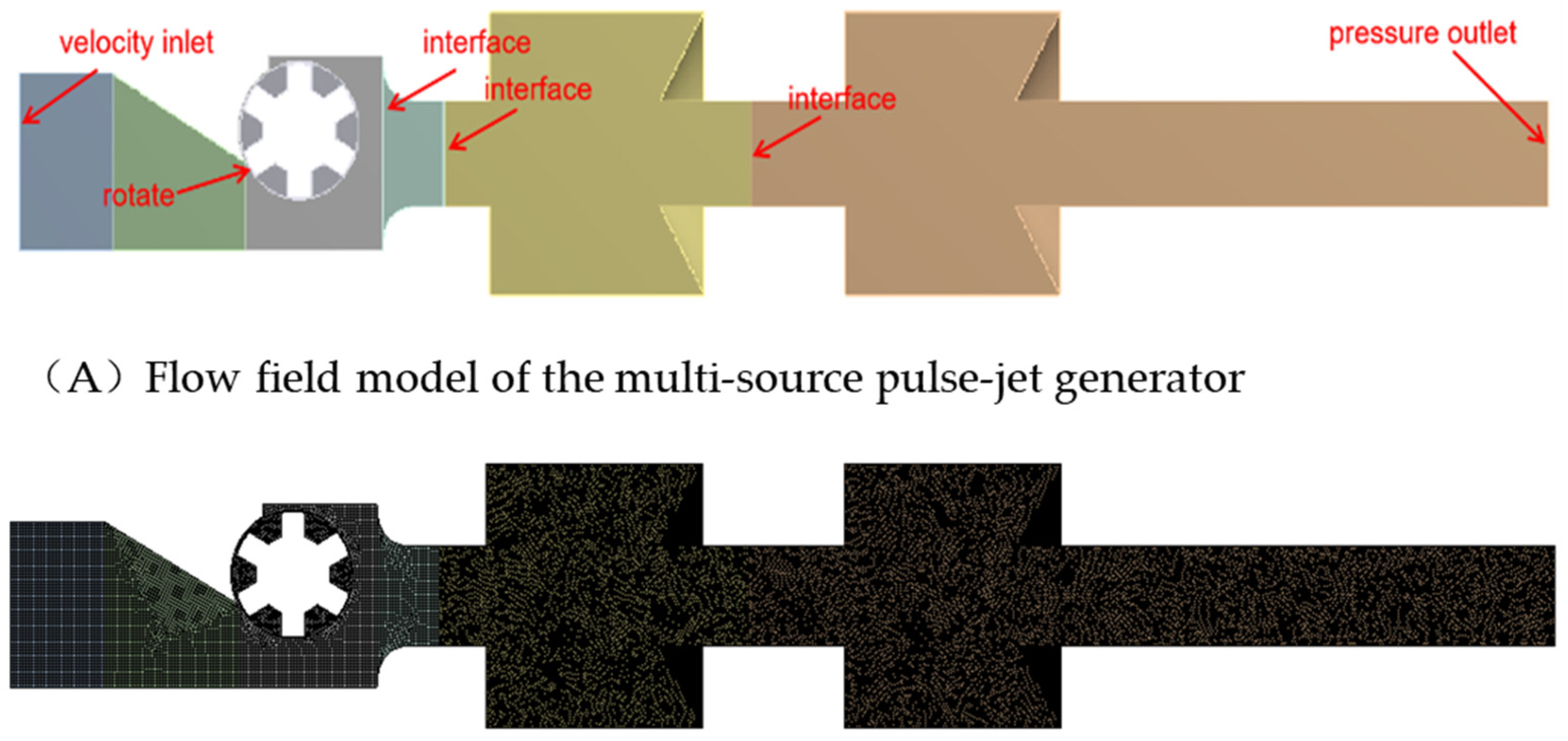
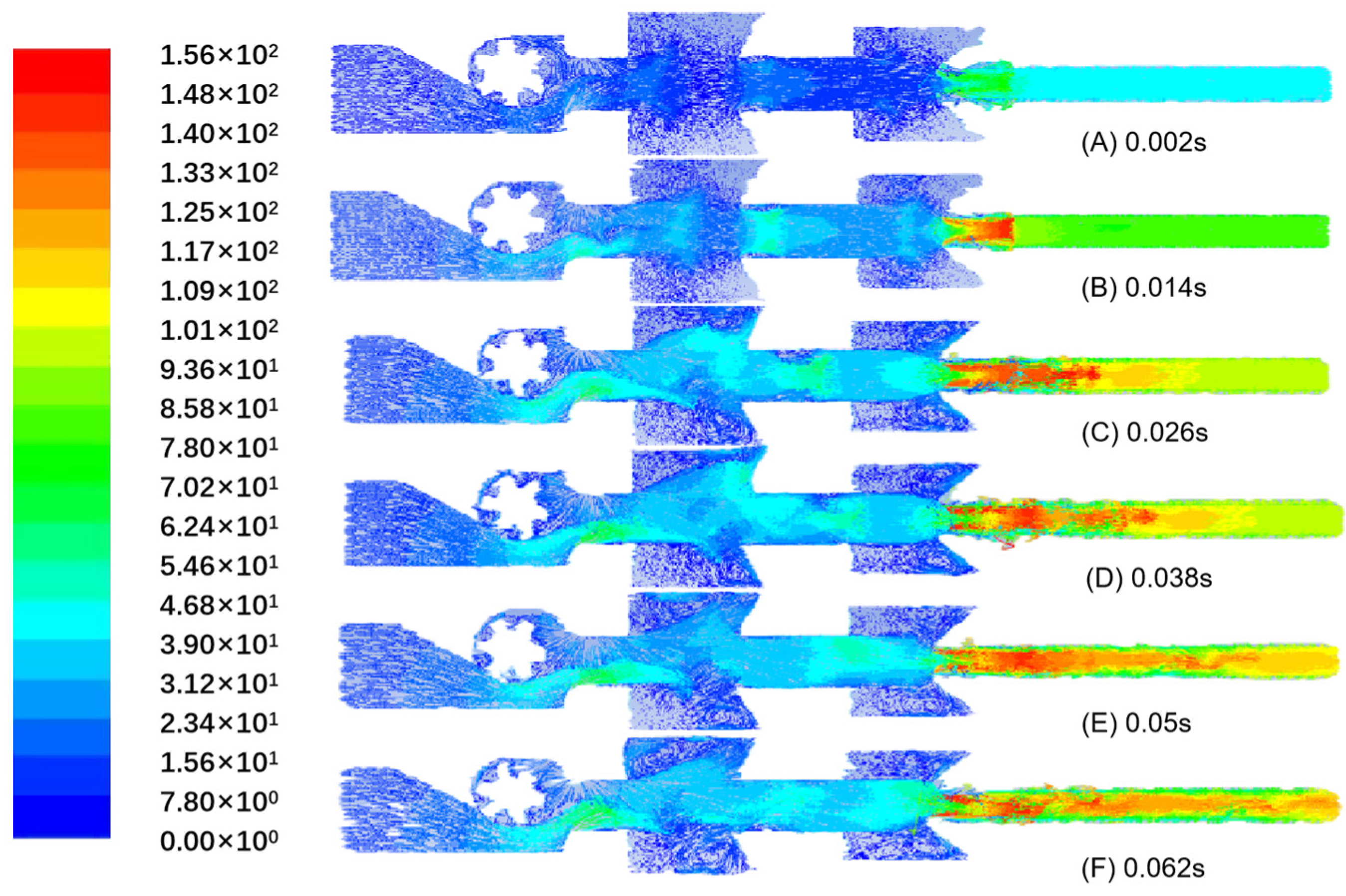
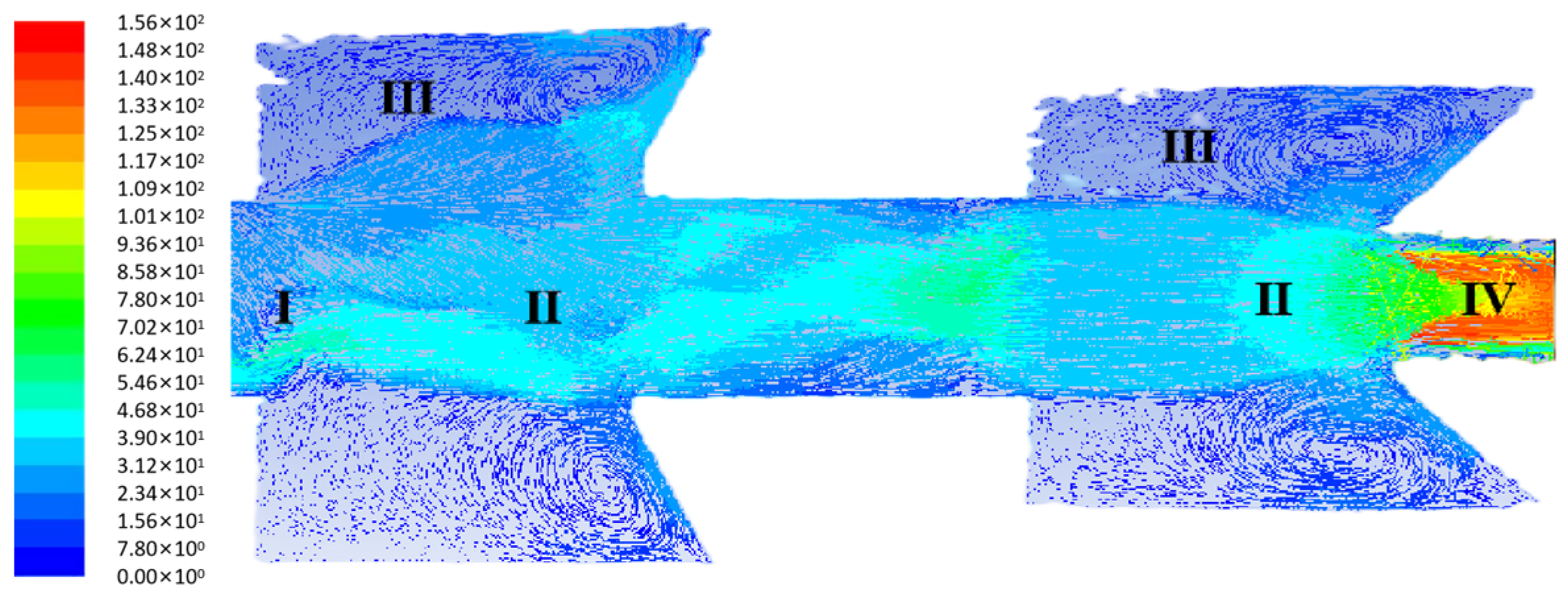


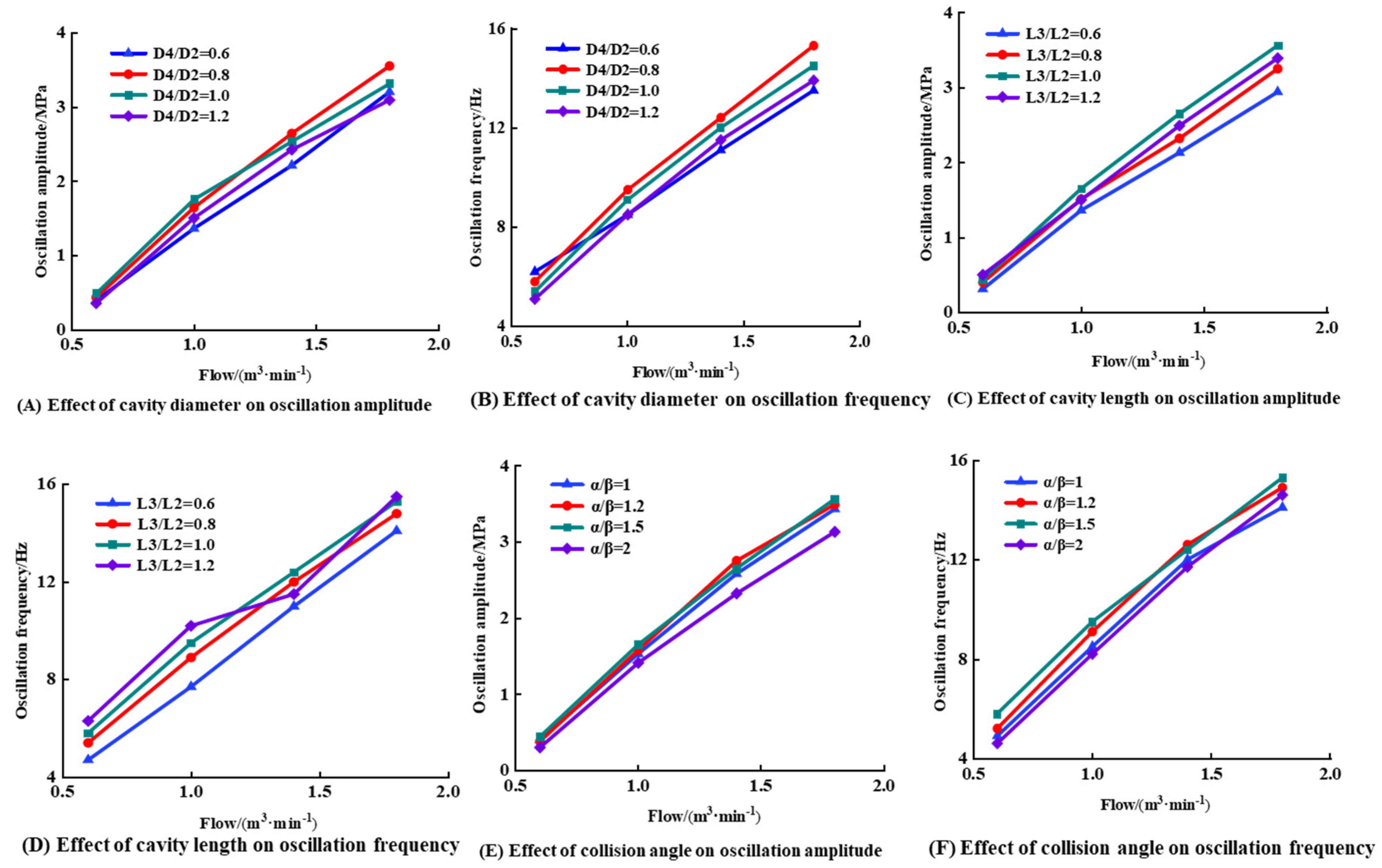
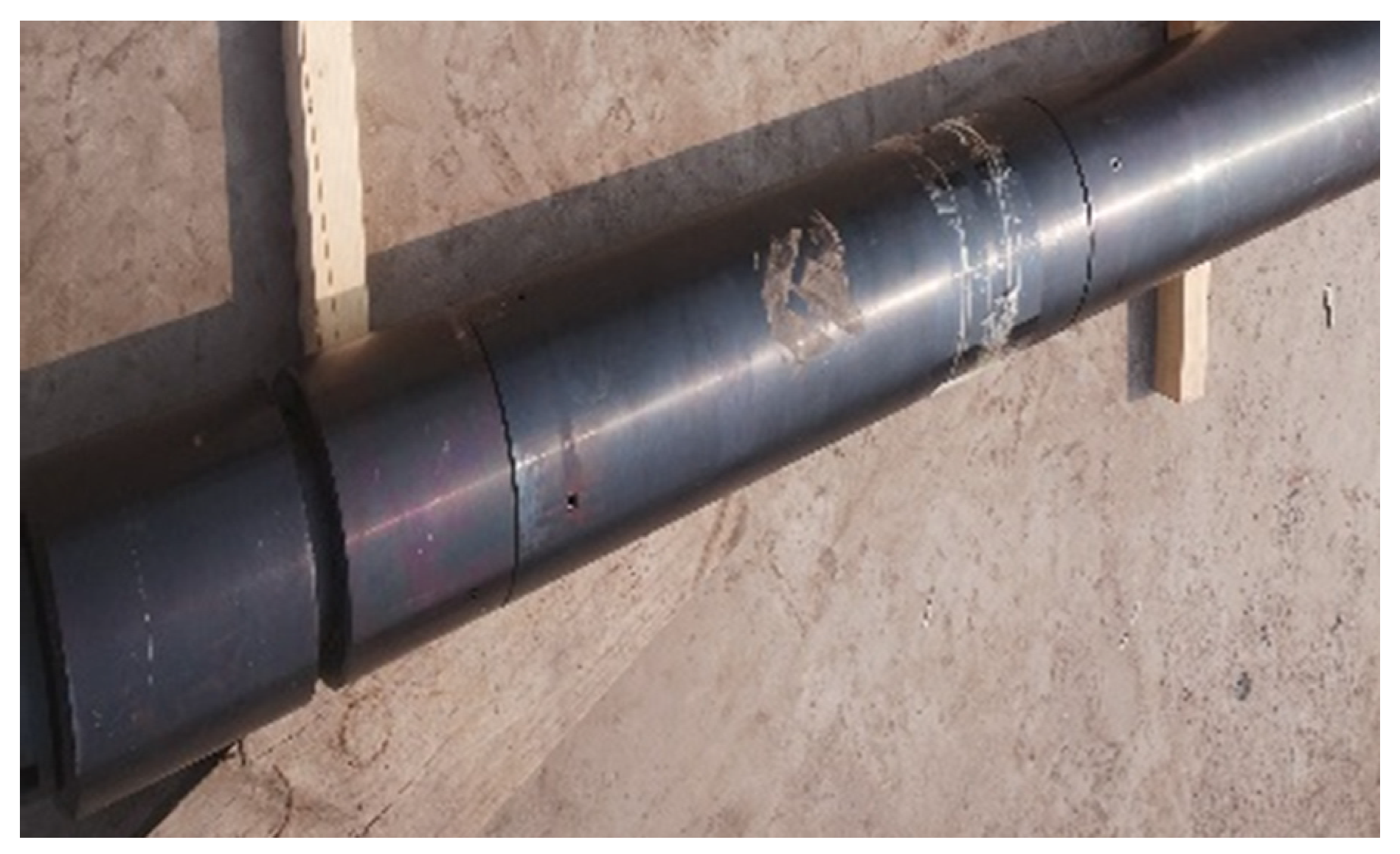

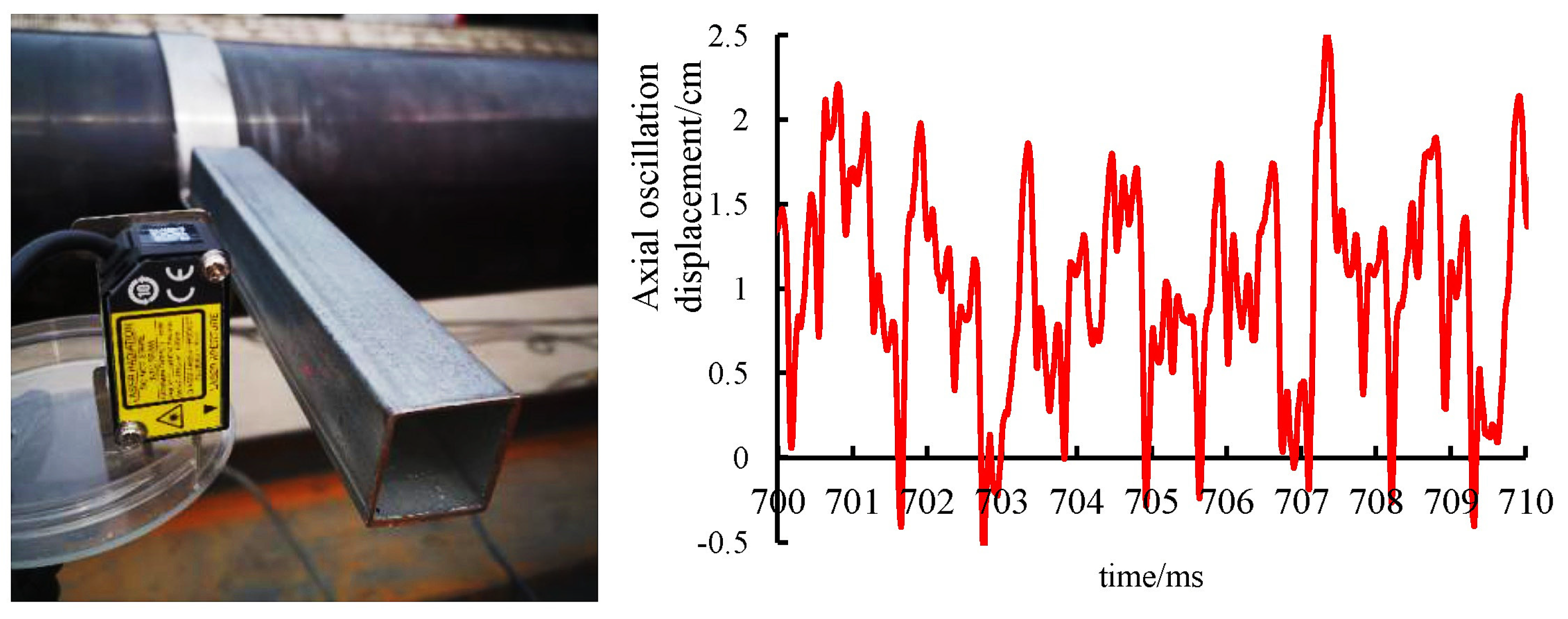
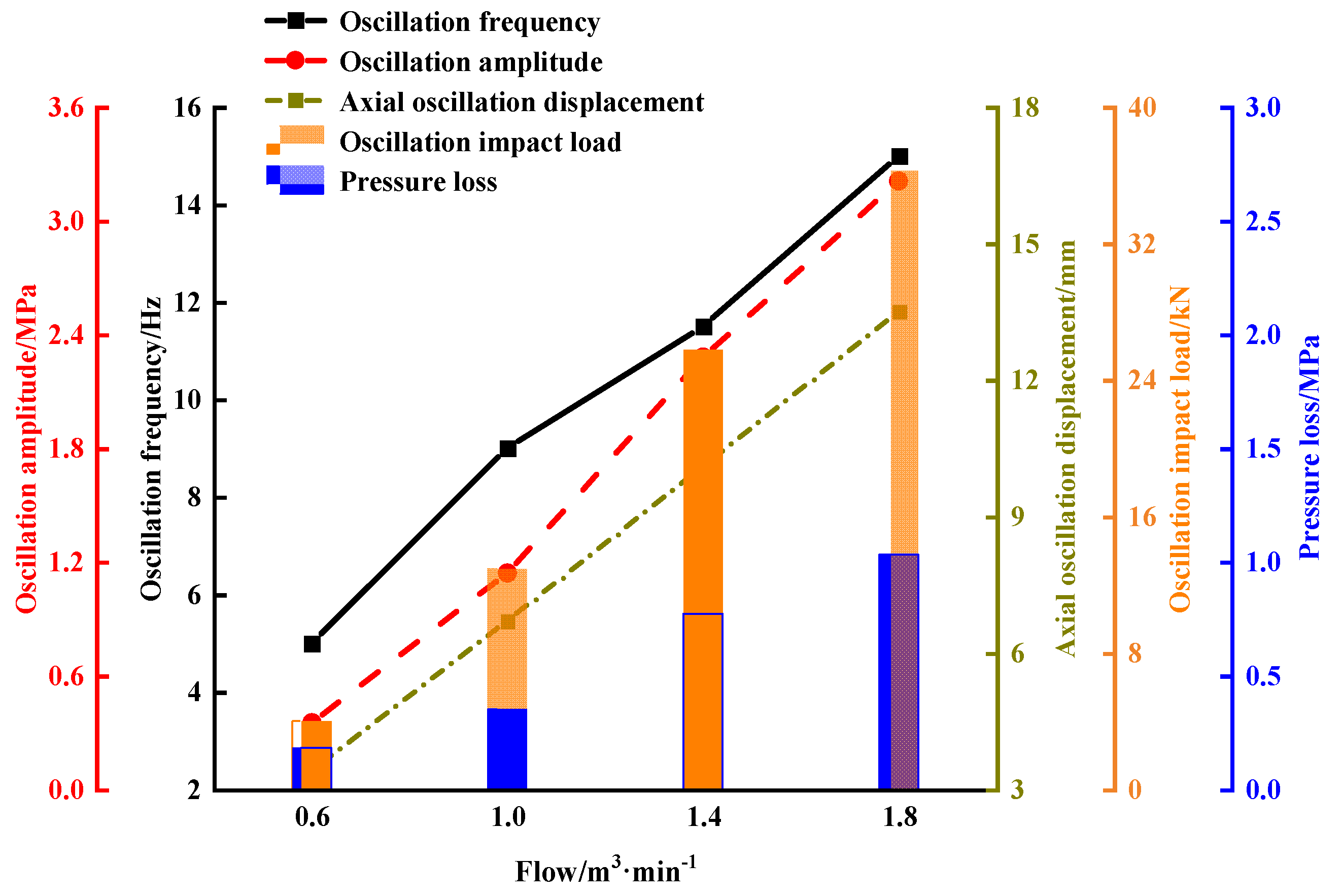
| Exit Diameter/mm | Group A | Group B | Group C | |||||||||
|---|---|---|---|---|---|---|---|---|---|---|---|---|
| L3/L2 | D4/D2 | α/β | ||||||||||
| 0.6 | 0.8 | 1 | 1.2 | 0.6 | 0.8 | 1 | 1.2 | 1 | 1.2 | 1.5 | 2 | |
| 18 | A1 | A2 | A3 | A4 | B1 | B2 | B3 | B4 | C1 | C2 | C3 | C4 |
| Serial Number | Rate of Flow/(m3·min−1) | Cavity Diameter Ratios (D4/D2) | Cavity Length Ratios (L3/L2) | Inner Wall Collision Angle Ratios (α/β) |
|---|---|---|---|---|
| 1 | 0.6 1.0 1.4 1.8 | 0.8 | 0.6, 0.8, 1.0, 1.2 | 1.5 |
| 2 | 0.6, 0.8, 1.0, 1.2 | 1.0 | 1.0, 1.2, 1.5, 2.0 | |
| 3 | 0.8 | 1.0 | 1.5 |
Disclaimer/Publisher’s Note: The statements, opinions and data contained in all publications are solely those of the individual author(s) and contributor(s) and not of MDPI and/or the editor(s). MDPI and/or the editor(s) disclaim responsibility for any injury to people or property resulting from any ideas, methods, instructions or products referred to in the content. |
© 2023 by the authors. Licensee MDPI, Basel, Switzerland. This article is an open access article distributed under the terms and conditions of the Creative Commons Attribution (CC BY) license (https://creativecommons.org/licenses/by/4.0/).
Share and Cite
Niu, W.; Liao, H.; Wang, H.; Wei, J.; Liu, J.; Niu, J.; Shi, Y. Study of the Jet Output Characteristics under Multi−Source Coupling. Processes 2023, 11, 900. https://doi.org/10.3390/pr11030900
Niu W, Liao H, Wang H, Wei J, Liu J, Niu J, Shi Y. Study of the Jet Output Characteristics under Multi−Source Coupling. Processes. 2023; 11(3):900. https://doi.org/10.3390/pr11030900
Chicago/Turabian StyleNiu, Wenlong, Hualin Liao, Huajian Wang, Jun Wei, Jiansheng Liu, Jilei Niu, and Yucai Shi. 2023. "Study of the Jet Output Characteristics under Multi−Source Coupling" Processes 11, no. 3: 900. https://doi.org/10.3390/pr11030900




